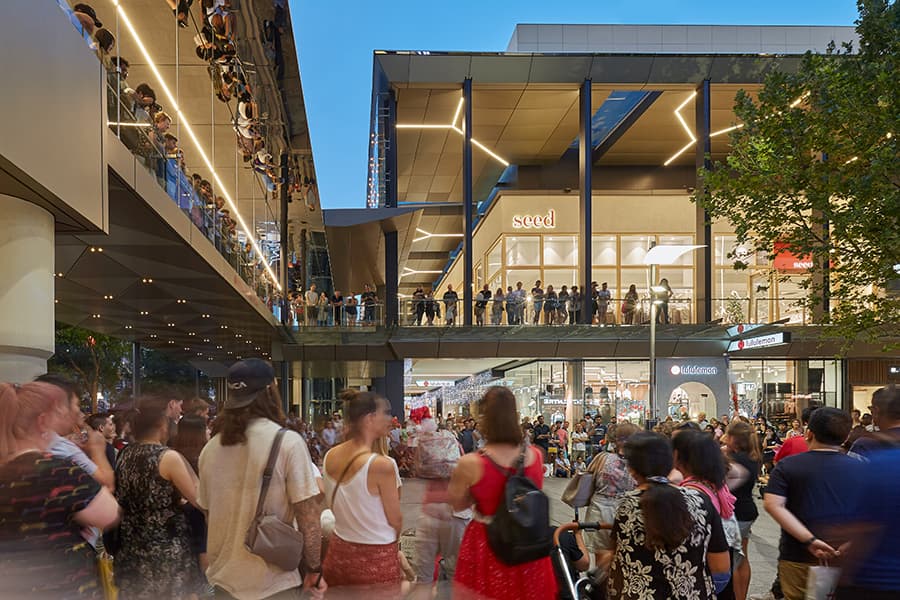At the height of the COVID-19 outbreak in Australia, the news was flooded with hundreds of iconic Australian stores closing their doors. As the nation braced for the pandemic’s impact on our health system, we were also warned about an economic downturn that would affect us for years to come; a downturn that will accelerate changes to Australia’s retail landscape forever. This article, written collaboratively by Hames Sharley’s Retail & Towns Centre Portfolio Leader, Harold Perks and Director, Derek Hays, explores how coronavirus will impact the future of retail.
As the country ends lockdown and stores begin to re-open, how will retail reshape itself amidst the possibility of ongoing social distancing requirements? What impact will this have on landlords when it comes to planning and managing space? And how will new developments adjust their plans to suit?
Post-pandemic retail
There are currently a number of research projects underway which will explore in detail how the pandemic might affect the future of retailing. Until we have that data to work with, we can only speculate just how greatly the COVID-19 pandemic has affected the industry in Australia.
However, many of the changes we expect to see were already on the cards. We’ve been talking about the future of retail for quite some time; how a rise in online shopping will reduce store sizes and make way for showrooming; how shopping centres will expand beyond mixed-use precincts to become community hubs; and how a shift away from global consumerism might see Australian owned and locally made a focus for consumers once again. These are changes we expected to see five to 10 years from now – but due to COVID-19 that timeline will no doubt be accelerated.
Beyond fast-tracking the shopping centre of the future, the pandemic has added another layer of complexities. The uncertainty of how long social distancing will remain is problematic, with developers, landlords and tenants forced to rethink future projects. Will cinema layouts need to be adjusted? Will food courts be able to exist in the same way? These very real concerns have put plans on pause as we wait to see how this plays out over the coming months, if not years.
Time for reinvention
In the immediate term, landlords will be looking for new ways to fill space. Although many retailers will come back after lockdown, many won’t have survived; and in this climate, if retailers fall over they won’t get replaced overnight. So landlords will need to think outside the box in order to fill those tenancies.
That might mean bringing a few food trucks into the centre to fill a vacant space and create pockets of engaging experimentation. Or creating a new style of co-working environment that meets both remote working and social distancing requirements. If there was ever a time for flexibility and ingenuity, it is now. Yes, it will be a challenge to fill the gaps, but what a fantastic opportunity to be creative and test out new ideas.
Social distancing and the immediate legacy of what we have just been through will continue to fade out over time and landlords, retailers and customers all need to adjust appropriately before we get back to a “normalised” environment. With the likelihood of spare real estate, there will be short-term opportunities to innovate around the 1.5m rule until things settle off down the track.

Karrinyup Shopping Centre Development: West Deck – Dining & Entertainment Precinct
Showrooming and experience
Getting people in store may also pose new challenges post-lockdown, following the dramatic uptake of online shopping. After it closed its bricks and mortar stores, Myer rehired 2,000 staff to cope with online demand, while delivery windows at Woolworths and Coles were booked days in advance. With the mystery and fear surrounding online shopping evaporating overnight, we can only assume a prevalence for online purchasing will continue.
As retailers move to shift the bulk of their sales online, they won’t require anywhere near as much floor space. Downsizing will see stores transform into showrooms; a destination that provides a sensory experience where customers can feel, see, touch, and try on products.
Of course, there’ll need to be different experiences for different audiences, and that’s where things will get interesting. We’re going to see a lot of innovation as retailers find creative new ways to get customers through the door.
Perhaps we’ll see a blend of services – fashion outlets that start selling coffee or offering tailoring or shoe-shining services. We’ll see limited edition products available only in stores, or the ability to customise products to suit your own tastes grow in-store to maintain footfall. Perhaps we’ll even see showrooming evolve into a platform for customer events that can also be live streamed for global access; used for product launches, range updates, or simply product education pieces for ongoing customer engagement. In today’s social media lifestyle, being seen at events, launches and experiences is a key factor that retailers will likely exploit. Whatever the experience, it will need to provide customers with a unique and compelling way to engage.
Future proofing
If this pandemic has taught us one thing, it’s that essential services are the most resilient retail partners. While department stores, fashion boutiques and even eateries closed their doors, banks, butchers, chemists and supermarkets continued trading. Moving forward, landlords would be wise to ensure a strong contingent of retail partners who offer essential services as a buffer for future crises; in addition to a greater blending of general retailing and fashion merchandise with ‘essential services’ to create a more robust retail model.
And what of other sectors? We’re already seeing higher demand for mixed-use precincts, so it would make sense that more retail environments evolve to incorporate a diverse tenant mix within the retail centres themselves; from corporate offices to residences and places of education. Even healthcare – we’ve seen firsthand that when the chips are down, health becomes a priority. So, adding a greater degree of healthcare into the retail landscape seems like a sensible inclusion.
Flexibility is key
The COVID-19 pandemic has had a significant impact on retail, but retail will survive. After all, retail is the one sector that has continually changed throughout the ages. For landlords and retailers alike, success will come down to the ability to adapt and change to the current situation. In the short term, that will mean providing new platforms to engage with consumers on high alert as they re-enter the public realm. In the longer term, that will mean continued, deliberate, flexibility and versatility as we navigate ongoing changes.
One thing is clear – this isn’t the time to be lazy and assume that whatever worked before will work again; a post-pandemic world in these modern times is uncharted territory. However, with a flexible mindset and a willingness to innovate, retail will not only survive, it will flourish.





















